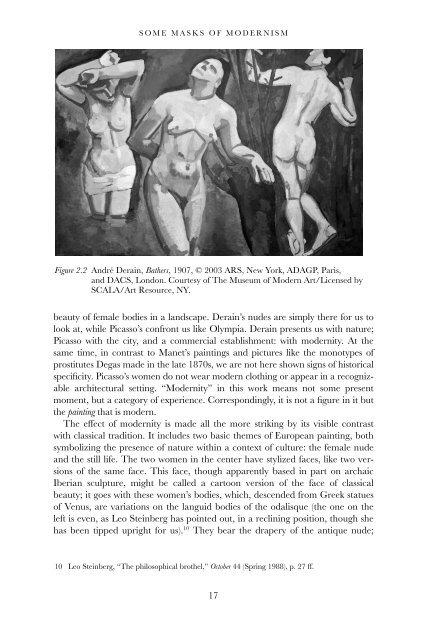Art in its Time: Theories and Practices of Modern Aesthetics
Art in its Time: Theories and Practices of Modern Aesthetics
Art in its Time: Theories and Practices of Modern Aesthetics
Create successful ePaper yourself
Turn your PDF publications into a flip-book with our unique Google optimized e-Paper software.
SOME MASKS OF MODERNISM<br />
Figure 2.2 André Dera<strong>in</strong>, Bathers, 1907, © 2003 ARS, New York, ADAGP, Paris,<br />
<strong>and</strong> DACS, London. Courtesy <strong>of</strong> The Museum <strong>of</strong> <strong>Modern</strong> <strong>Art</strong>/Licensed by<br />
SCALA/<strong>Art</strong> Resource, NY.<br />
beauty <strong>of</strong> female bodies <strong>in</strong> a l<strong>and</strong>scape. Dera<strong>in</strong>’s nudes are simply there for us to<br />
look at, while Picasso’s confront us like Olympia. Dera<strong>in</strong> presents us with nature;<br />
Picasso with the city, <strong>and</strong> a commercial establishment: with modernity. At the<br />
same time, <strong>in</strong> contrast to Manet’s pa<strong>in</strong>t<strong>in</strong>gs <strong>and</strong> pictures like the monotypes <strong>of</strong><br />
prostitutes Degas made <strong>in</strong> the late 1870s, we are not here shown signs <strong>of</strong> historical<br />
specificity. Picasso’s women do not wear modern cloth<strong>in</strong>g or appear <strong>in</strong> a recognizable<br />
architectural sett<strong>in</strong>g. “<strong>Modern</strong>ity” <strong>in</strong> this work means not some present<br />
moment, but a category <strong>of</strong> experience. Correspond<strong>in</strong>gly, it is not a figure <strong>in</strong> it but<br />
the pa<strong>in</strong>t<strong>in</strong>g that is modern.<br />
The effect <strong>of</strong> modernity is made all the more strik<strong>in</strong>g by <strong>its</strong> visible contrast<br />
with classical tradition. It <strong>in</strong>cludes two basic themes <strong>of</strong> European pa<strong>in</strong>t<strong>in</strong>g, both<br />
symboliz<strong>in</strong>g the presence <strong>of</strong> nature with<strong>in</strong> a context <strong>of</strong> culture: the female nude<br />
<strong>and</strong> the still life. The two women <strong>in</strong> the center have stylized faces, like two versions<br />
<strong>of</strong> the same face. This face, though apparently based <strong>in</strong> part on archaic<br />
Iberian sculpture, might be called a cartoon version <strong>of</strong> the face <strong>of</strong> classical<br />
beauty; it goes with these women’s bodies, which, descended from Greek statues<br />
<strong>of</strong> Venus, are variations on the languid bodies <strong>of</strong> the odalisque (the one on the<br />
left is even, as Leo Ste<strong>in</strong>berg has po<strong>in</strong>ted out, <strong>in</strong> a recl<strong>in</strong><strong>in</strong>g position, though she<br />
has been tipped upright for us). 10 They bear the drapery <strong>of</strong> the antique nude;<br />
10 Leo Ste<strong>in</strong>berg, “The philosophical brothel,” October 44 (Spr<strong>in</strong>g 1988), p. 27 ff.<br />
17
















